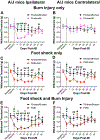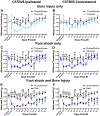The impact of foot shock-induced stress on pain-related behavior associated with burn injury
- PMID: 33958242
- PMCID: PMC8526636
- DOI: 10.1016/j.burns.2021.04.010
The impact of foot shock-induced stress on pain-related behavior associated with burn injury
Abstract
Acute pain is prevalent following burn injury and can often transition to chronic pain. Prolonged acute pain is an important risk factor for chronic pain and there is little preclinical research to address this problem. Using a mouse model of second-degree burn, we investigated whether pre-existing stress influences pain(sensitivity) after a burn injury. We introduced a contribution of stress in two different ways: (1) the use of foot-shock as a pre-injury stressor or (2) the use of A/J mice to represent higher pre-existing stress compared to C57Bl/6 mice. C57Bl/6 and A/J mice were exposed to repeated mild foot shock to induce stress for 10 continuous days and mice underwent either burn injury or sham burn injury of the plantar surface of the right hind paw. Assessments of mechanical and thermal sensitivities of the injured and uninjured paw were conducted during the shock protocol and at intervals up to 82-day post-burn injury. In both strains of mice that underwent burn injury, thermal hypersensitivity and mechanical allodynia appeared rapidly in the ipsilateral paw. Mice that were stressed took much longer to recover their hind paw mechanical thresholds to baseline compared to non-stressed mice in both burn and non-burn groups. Analysis of the two mouse strains revealed that the recovery of mechanical thresholds in A/J mice which display higher levels of baseline anxiety was shorter than C57Bl/6 mice. No differences were observed regarding thermal sensitivities between strains. Our results support the view that stress exposure prior to burn injury affects mechanical and thermal thresholds and may be relevant to as a risk factor for the transition from acute to chronic pain. Finally, genetic differences may play a key role in modality-specific recovery following burn injury.
Keywords: Burn; Mechanical allodynia; Mouse; Paw; Strain; Stress.
Copyright © 2021 Elsevier Ltd and ISBI. All rights reserved.
Conflict of interest statement
Conflict of interest
The authors declare no competing financial interests.
Figures






Similar articles
-
Role of complement anaphylatoxin receptors in a mouse model of acute burn-induced pain.Mol Immunol. 2018 Feb;94:68-74. doi: 10.1016/j.molimm.2017.12.016. Epub 2017 Dec 21. Mol Immunol. 2018. PMID: 29274925
-
shRNA mediated knockdown of Nav1.7 in rat dorsal root ganglion attenuates pain following burn injury.BMC Anesthesiol. 2016 Aug 11;16(1):59. doi: 10.1186/s12871-016-0215-0. BMC Anesthesiol. 2016. PMID: 27514860 Free PMC article.
-
Hydrocodone, but Neither Morphine nor Oxycodone, Is Effective in Suppressing Burn-Induced Mechanical Allodynia in the Uninjured Foot Contralateral to the Burn.J Burn Care Res. 2017 Sep/Oct;38(5):319-326. doi: 10.1097/BCR.0000000000000517. J Burn Care Res. 2017. PMID: 28319527
-
Prior stress exposure increases pain behaviors in a rat model of full thickness thermal injury.Burns. 2015 Dec;41(8):1796-1804. doi: 10.1016/j.burns.2015.09.007. Epub 2015 Oct 1. Burns. 2015. PMID: 26432505
-
Role of the NLRP3 inflammasome in a model of acute burn-induced pain.Burns. 2017 Mar;43(2):304-309. doi: 10.1016/j.burns.2016.09.001. Epub 2016 Dec 28. Burns. 2017. PMID: 28040362
Cited by
-
Serotonin mediates stress-like effects on responses to non-nociceptive stimuli in the medicinal leech Hirudo verbana.J Exp Biol. 2022 Jun 1;225(11):jeb243404. doi: 10.1242/jeb.243404. Epub 2022 Jun 9. J Exp Biol. 2022. PMID: 35510636 Free PMC article.
References
-
- Organization WH. The global burden of disease. In: WHO, editor. Disease burden; 2000–2016. https://www.who.int/healthinfo/global_burden_disease/estimates/en/index1....
-
- Prevention CfDCa. Burns fact sheet. Centers for Disease Control and Prevention.
-
- Dauber A, Osgood PF, Breslau AJ, Vernon HL, Carr DB. Chronic persistent pain after severe burns: a survey of 358 burn survivors. Pain Med (Malden, MA) 2002;3:6–17. - PubMed
-
- Fukunishi I Relationship of cosmetic disfigurement to the severity of posttraumatic stress disorder in burn injury or digital amputation. Psychother Psychosom 1999;68:82–6. - PubMed
-
- Fauerbach JA, Lawrence J, Haythornthwaite J, Richter D, McGuire M, Schmidt C, et al. Preburn psychiatric history affects posttrauma morbidity. Psychosomatics 1997;38:374–85. - PubMed
Publication types
MeSH terms
Grants and funding
LinkOut - more resources
Full Text Sources
Other Literature Sources
Medical

